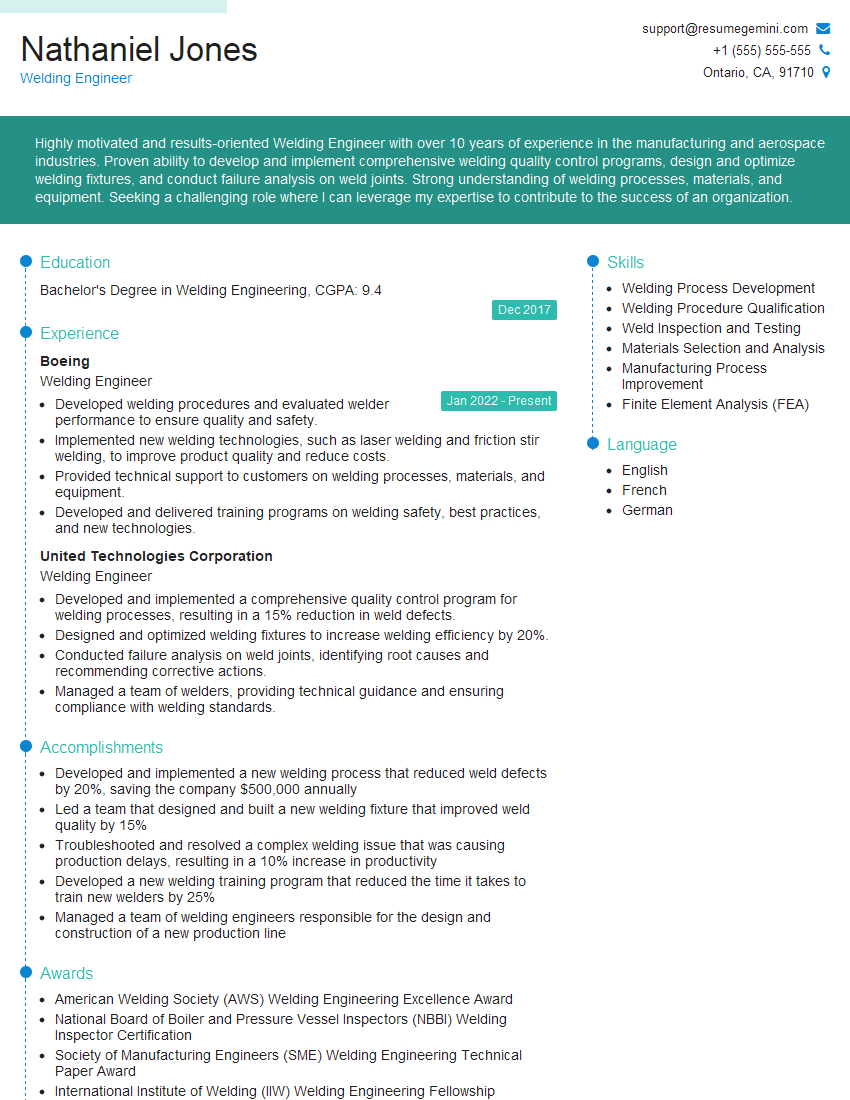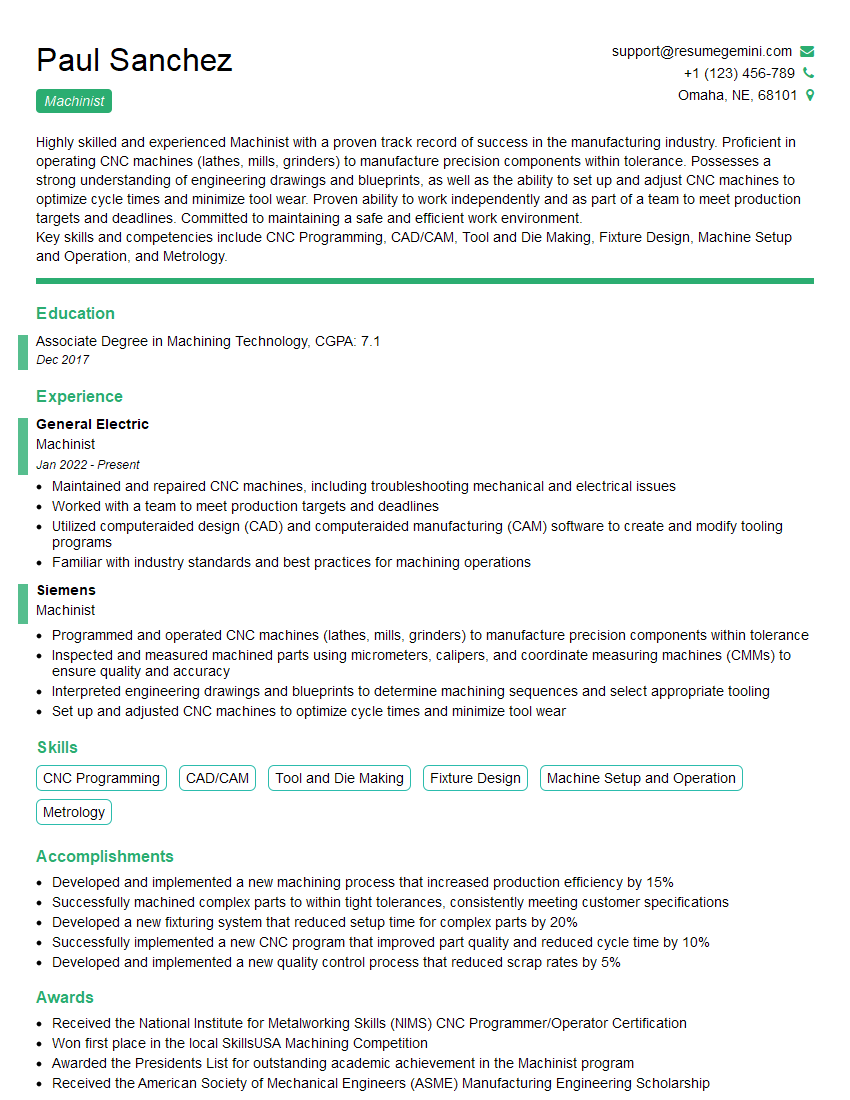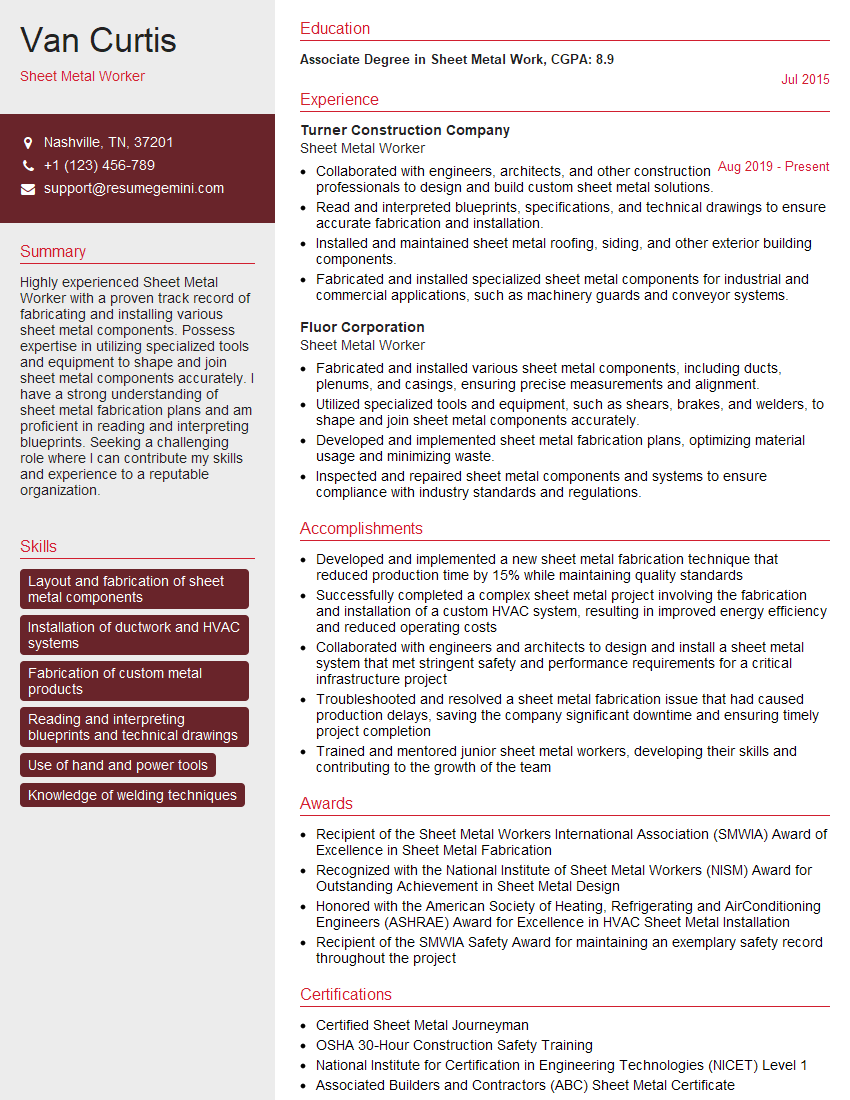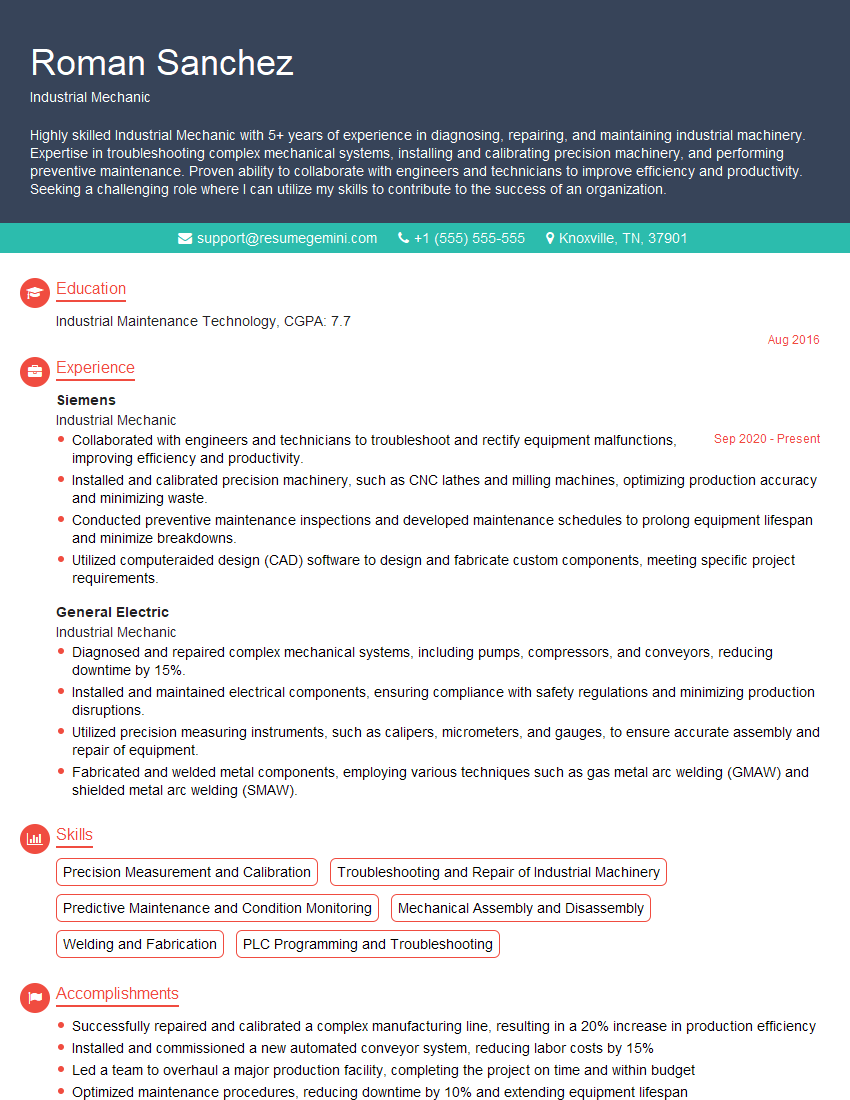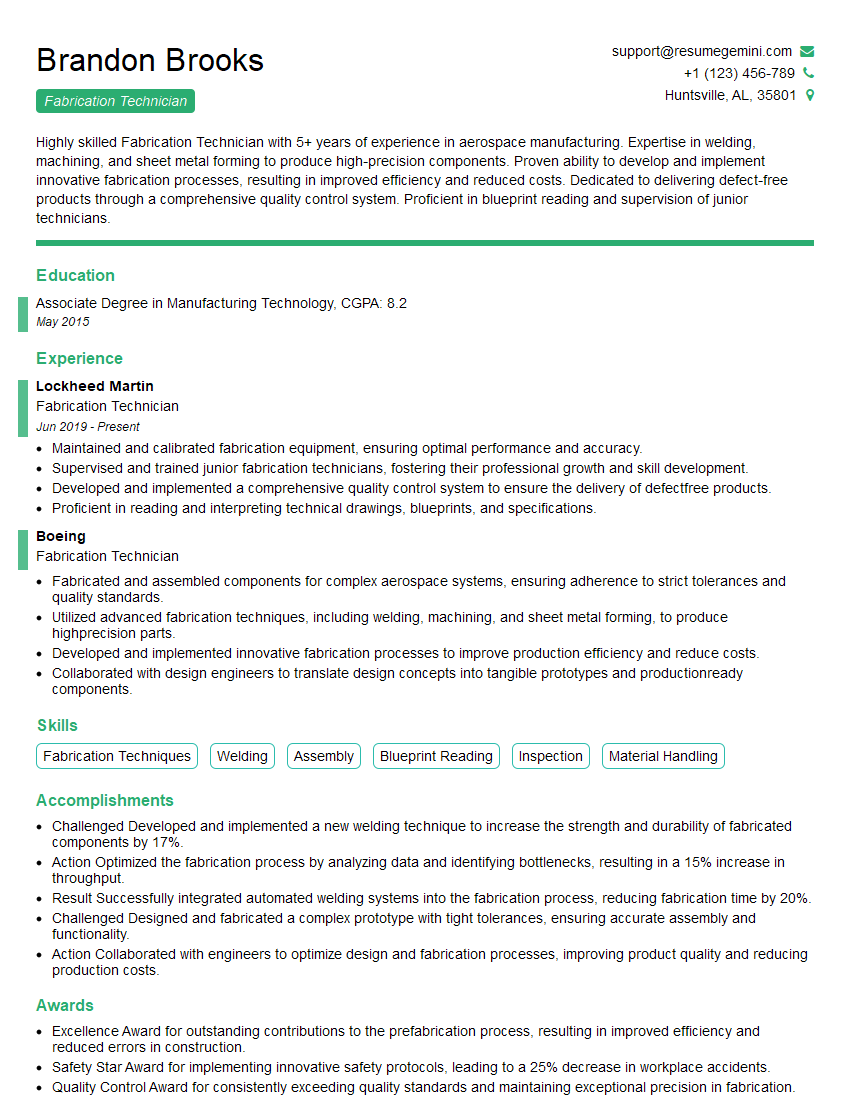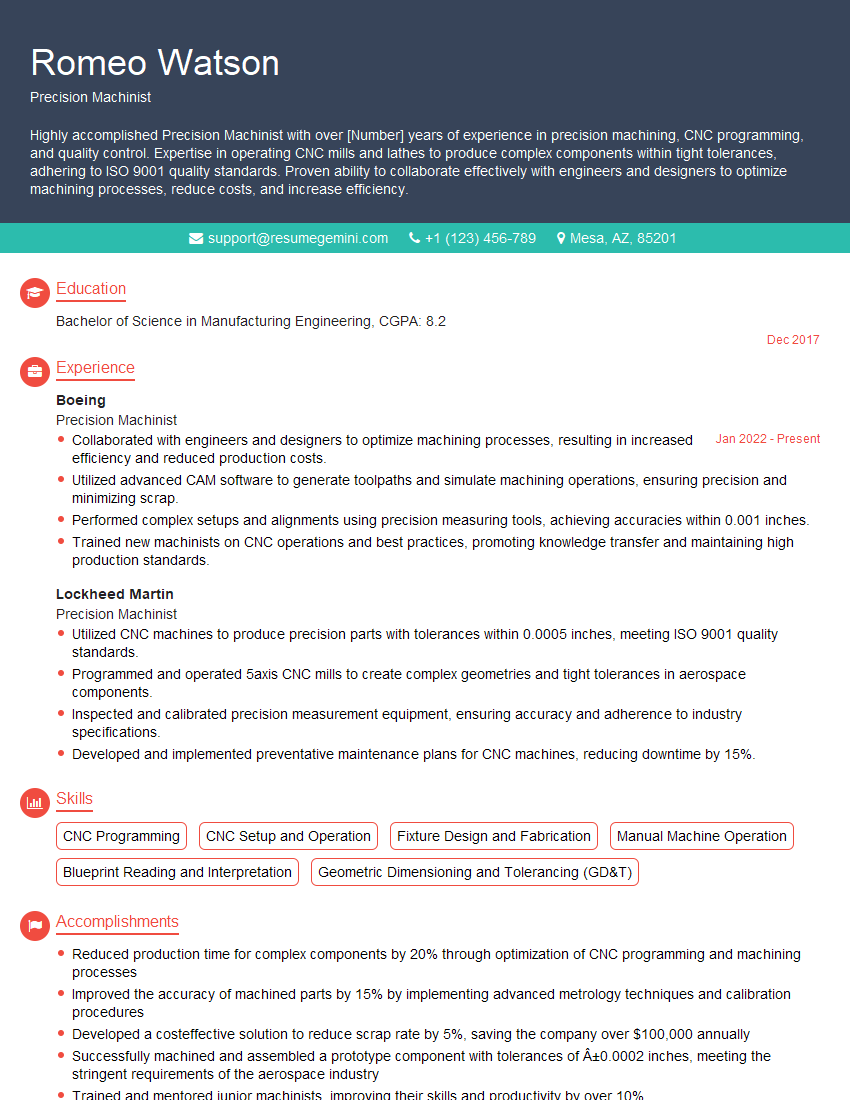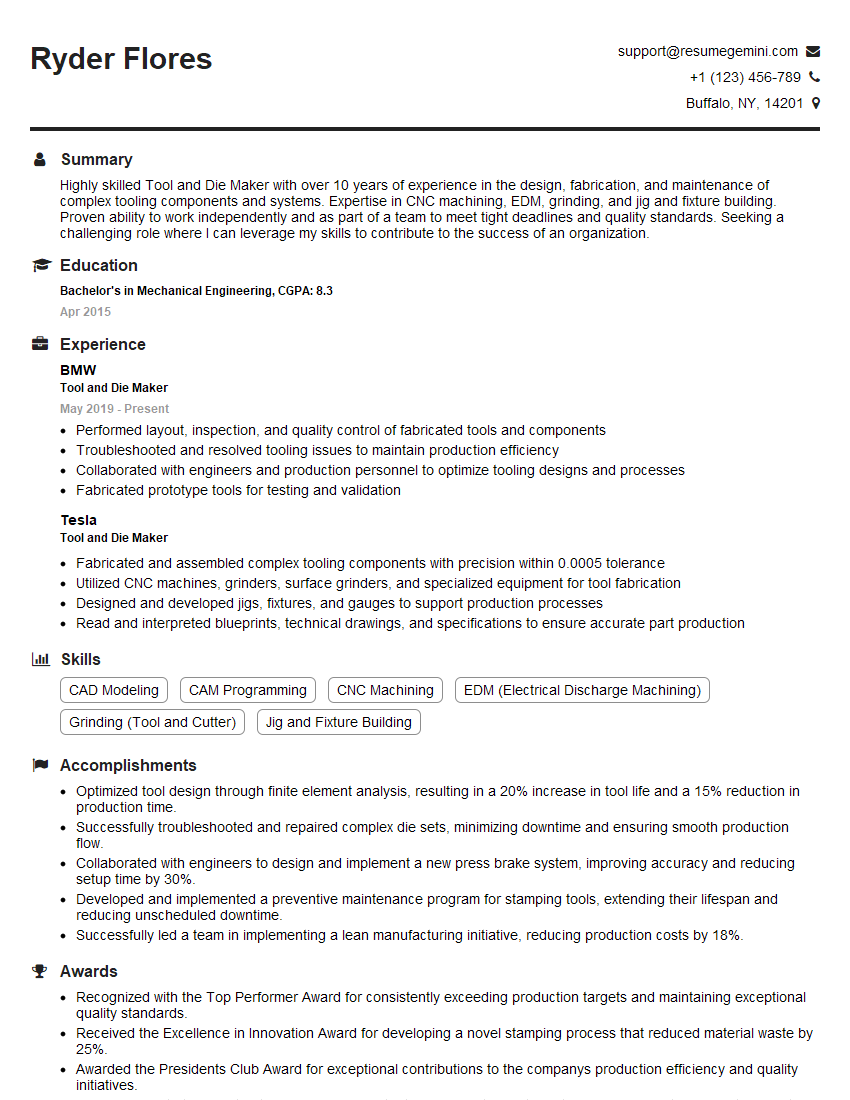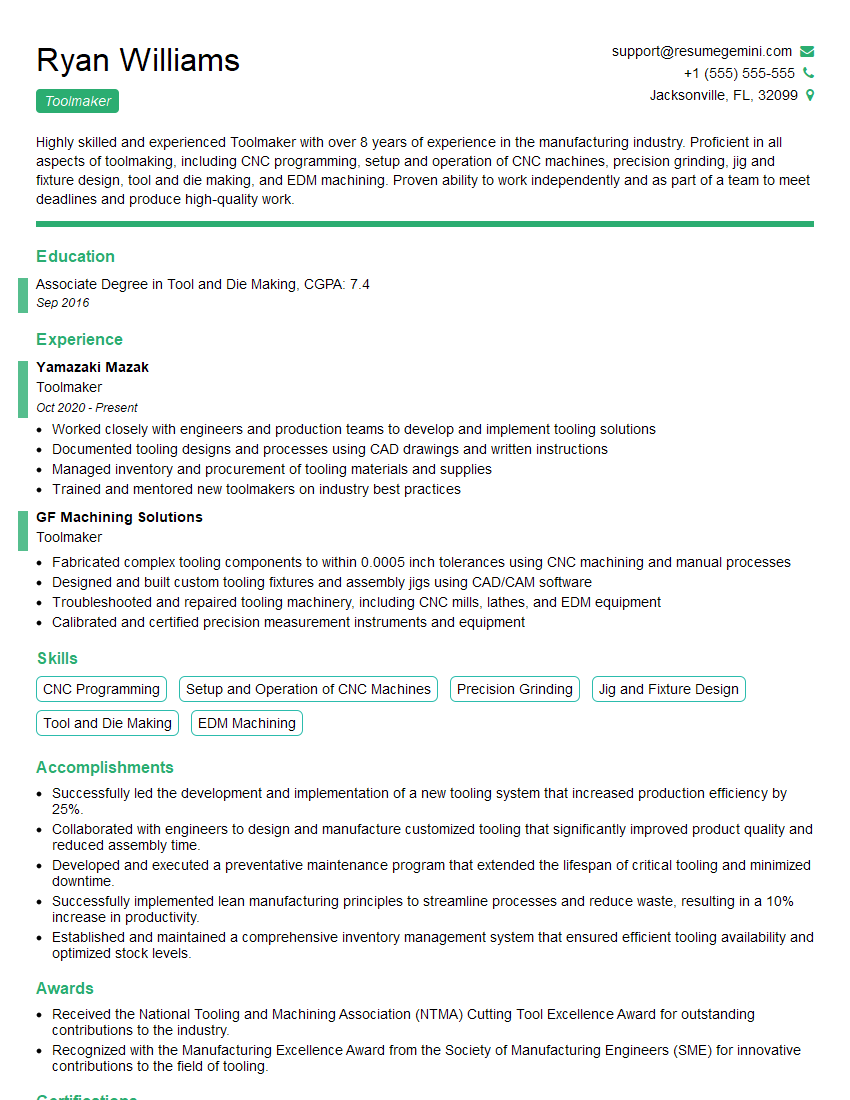The right preparation can turn an interview into an opportunity to showcase your expertise. This guide to Cutting Metals interview questions is your ultimate resource, providing key insights and tips to help you ace your responses and stand out as a top candidate.
Questions Asked in Cutting Metals Interview
Q 1. Explain the difference between various cutting tool materials (e.g., carbide, high-speed steel).
Cutting tool materials significantly impact machining performance. The choice depends on the workpiece material, desired surface finish, and machining operation. Here’s a comparison of common materials:
- High-Speed Steel (HSS): A versatile material offering good toughness and wear resistance. It’s relatively inexpensive, making it suitable for general-purpose applications and less demanding materials. However, its cutting speed is lower compared to newer materials.
- Carbide: Composed of tungsten carbide (WC) and cobalt (Co), carbide tools are significantly harder and more wear-resistant than HSS. This translates to higher cutting speeds, improved surface finishes, and longer tool life. They are ideal for machining tougher materials like hardened steels and cast irons but are more brittle than HSS.
- Ceramics: These tools exhibit even higher hardness and wear resistance than carbides, enabling exceptionally high cutting speeds and excellent surface finishes. However, they are brittle and susceptible to chipping, limiting their applicability to specific operations and materials.
- Cubic Boron Nitride (CBN): CBN tools are the hardest material commonly used in cutting tools, surpassing even ceramics. They excel in machining very hard and abrasive materials like hardened steels, superalloys, and ceramics. However, they’re expensive and require specific machining conditions.
- Polycrystalline Diamond (PCD): PCD tools offer exceptional hardness and wear resistance, ideal for machining non-ferrous materials like aluminum, composites, and graphite. They are very sharp and provide excellent surface finish.
Example: For roughing a mild steel part, HSS might suffice. However, for finishing a hardened steel component, carbide or even CBN would be necessary to achieve the required precision and surface finish.
Q 2. Describe different types of cutting fluids and their applications.
Cutting fluids, also known as coolants or lubricants, play a crucial role in metal cutting. They serve multiple purposes, including cooling, lubrication, and chip removal. Types include:
- Water-Miscible Fluids (Emulsions): These are mixtures of water and oil, offering a good balance of cooling and lubrication. They are widely used due to their cost-effectiveness and relatively good performance. However, they can be prone to bacterial growth and require regular maintenance.
- Straight Oils: These are petroleum-based fluids providing excellent lubrication but limited cooling capacity. They are suitable for operations where lubrication is paramount, such as deep hole drilling or high-pressure cutting.
- Synthetic Fluids: These fluids are chemically engineered to offer specific properties like enhanced cooling, improved lubricity, or better environmental compatibility. They are often more expensive than water-miscible fluids or straight oils but can provide significant advantages in certain applications.
- Minimum Quantity Lubrication (MQL): This technique involves applying a very small amount of lubricant directly to the cutting zone. It’s environmentally friendly, reduces waste, and can improve surface finish in some cases, though it might not be suitable for all operations.
- Dry Machining: In some advanced applications, machining can be performed without any cutting fluid. This improves safety, reduces environmental impact, and can yield better surface finishes in certain materials. However, dry machining generates more heat, potentially limiting the cutting parameters.
Application Example: Water-miscible fluids are common for milling aluminum, while straight oils are often used for turning hardened steels.
Q 3. What are the factors influencing cutting speed, feed rate, and depth of cut?
Cutting speed, feed rate, and depth of cut are crucial parameters impacting machining efficiency and surface quality. Numerous factors influence them:
- Workpiece Material: Harder materials require lower cutting speeds and feed rates to prevent tool breakage. Tougher materials may also necessitate smaller depths of cut.
- Tool Material: The tool’s hardness and wear resistance dictate its maximum allowable cutting speed. More wear-resistant tools allow for higher speeds and feeds.
- Cutting Fluid: Proper lubrication and cooling enables higher cutting speeds and feed rates.
- Machining Operation: Turning typically allows for higher cutting speeds than milling or drilling.
- Machine Tool Rigidity: A more rigid machine can handle higher cutting forces, allowing for faster speeds and deeper cuts.
- Desired Surface Finish: Finer surface finishes often require lower feed rates and shallower depths of cut.
- Tool Geometry: The tool’s geometry, including rake angle, clearance angle, and nose radius, influences its ability to withstand higher speeds and feeds.
Example: Machining aluminum allows for much higher cutting speeds than machining titanium due to its lower hardness and higher thermal conductivity.
Q 4. How do you determine the appropriate cutting parameters for a specific material and operation?
Determining appropriate cutting parameters requires a combination of experience, reference data, and careful experimentation. Here’s a systematic approach:
- Consult Machining Handbooks or Databases: These resources provide recommended cutting parameters for various material-tool combinations.
- Consider Workpiece Material Properties: Understand the material’s hardness, toughness, machinability rating, and thermal properties.
- Select Appropriate Tool Material and Geometry: Choose a tool material and geometry that are compatible with the workpiece material and desired surface finish.
- Start with Conservative Parameters: Begin with lower cutting speeds, feed rates, and depths of cut than the maximum recommended values. This minimizes the risk of tool breakage or damage.
- Monitor Tool Wear and Surface Finish: Observe the tool’s condition and the surface finish of the workpiece during machining. Adjust parameters based on observations. Iterative adjustments are often necessary.
- Optimize Parameters: Gradually increase cutting parameters while monitoring for signs of tool wear or unacceptable surface finish. Aim to find the optimal balance between productivity and tool life.
Example: When machining stainless steel with a carbide insert, you’d start with conservative parameters, and progressively increase the cutting speed until a noticeable increase in tool wear or reduction in surface quality is detected. Then you back off slightly to reach a balance between productivity and tool life.
Q 5. Explain the concept of tool wear and its impact on machining accuracy.
Tool wear is the progressive deterioration of a cutting tool’s surface during machining. It leads to reduced tool life, compromised surface finish, and diminished dimensional accuracy. Several wear mechanisms contribute to this:
- Flank Wear: Wear on the tool flank (the surface not directly involved in cutting). It leads to increased friction and heat generation.
- Craters: Depressions formed on the rake face (cutting edge) due to the adhesive wear of workpiece material.
- Chipping: Sudden breakage of small pieces from the cutting edge.
- Plastic Deformation: Permanent deformation of the tool material.
Impact on Accuracy: As tools wear, their geometry changes, leading to dimensional inaccuracies, poor surface finish, and increased vibration. Excessive wear can result in parts that are out of tolerance, requiring rework or scrapping.
Example: Flank wear causes the tool to rub against the workpiece, creating friction and heat, leading to reduced accuracy.
Q 6. How do you measure tool wear and when should a tool be replaced?
Tool wear is routinely monitored using various techniques:
- Visual Inspection: Regularly inspect the tool for wear using a magnifying glass or microscope. Look for flank wear, crater wear, chipping, and other signs of deterioration.
- Wear Measurement Tools: Specialized tool wear measurement devices provide accurate readings of flank wear, crater depth, and other wear parameters.
- Force Sensors: Monitoring the cutting forces can indicate changes related to tool wear. Increased cutting forces often indicate higher wear levels.
When to Replace: The decision to replace a cutting tool depends on several factors, including the extent of wear, the acceptable tolerance for the machined part, and the cost of tool replacement. Replacing a worn tool before critical wear limits are reached minimizes the risk of producing scrap parts. Many shops use pre-defined wear limits based on the tool’s geometry and the application.
Example: If flank wear exceeds a predefined limit (e.g., 0.3mm), the tool should be replaced to avoid unacceptable dimensional errors in the machined parts.
Q 7. Describe different types of cutting processes (e.g., turning, milling, drilling).
Various cutting processes exist, each suited for specific applications:
- Turning: A process of removing material from a rotating workpiece using a single-point cutting tool. It’s used to create cylindrical shapes, shafts, and other axisymmetric parts.
- Milling: A process where a multi-tooth cutting tool removes material from a workpiece, typically in a planar or curved motion. It’s used for creating various shapes, slots, and surfaces.
- Drilling: Creating a cylindrical hole in a workpiece using a rotating tool with one or more cutting edges. Used for creating holes in various configurations and sizes.
- Boring: Enlarging an existing hole using a single-point cutting tool.
- Reaming: Precisely finishing a hole to a specific diameter using a multi-tooth cutting tool.
- Broaching: Creating shapes with multiple cutting edges in a single pass.
- Grinding: Using abrasive wheels to remove material and achieve very fine surface finishes.
Example: Turning is used to manufacture engine shafts, milling to create complex machine parts, and drilling to produce holes in circuit boards.
Q 8. Explain the importance of workholding and its impact on machining accuracy.
Workholding is absolutely crucial in metal cutting. Think of it as the foundation of a building – if the foundation is weak, the entire structure will suffer. In machining, workholding secures the workpiece, preventing it from moving during the cutting process. Without proper workholding, the workpiece can vibrate, shift, or even be ejected from the machine, leading to inaccurate cuts, damaged tools, and potentially serious injury.
The impact on accuracy is significant. Even slight movement can result in dimensional inaccuracies, surface imperfections (like chatter marks), and compromised tolerances. For instance, imagine trying to drill a precise hole in a part that’s slightly shifting; the hole will be off-center and unusable. Effective workholding ensures that the cutting tool engages the workpiece consistently and predictably, resulting in highly accurate and repeatable results. Different workholding devices cater to various workpiece shapes and machining operations. These include vises, chucks, fixtures, and magnetic bases, each with its own advantages and limitations.
Consider a scenario where a complex aerospace component requires tight tolerances. In such cases, specialized fixtures might be designed and manufactured to perfectly hold the component in position, minimizing the risk of errors and ensuring that the final product meets exacting standards.
Q 9. Describe different types of cutting fluids and their functions.
Cutting fluids, also known as coolants or lubricants, play a vital role in metal cutting. They’re not just about cooling; they perform several crucial functions that significantly impact machining efficiency and workpiece quality.
- Cooling: Cutting generates significant heat, which can damage the workpiece, tool, and machine. Coolants absorb this heat, preventing thermal distortion and extending tool life.
- Lubrication: Coolants reduce friction between the cutting tool and the workpiece, minimizing wear on both and improving the surface finish. This is particularly important in high-speed machining.
- Chip Removal: They help flush away chips and debris from the cutting zone, preventing them from interfering with the cutting process and improving the overall efficiency.
- Corrosion Prevention: Some coolants provide corrosion protection to prevent rust and oxidation on the machined surface.
Different types of cutting fluids exist, broadly classified as:
- Water-based fluids: These are environmentally friendly and cost-effective, offering good cooling and lubrication. However, they may not provide the same level of lubrication as oil-based fluids in certain applications.
- Oil-based fluids: These are excellent lubricants, especially in high-speed or heavy-duty machining operations. They offer superior chip control but are less environmentally friendly and can leave an oily residue.
- Synthetic fluids: Designed for specific applications, offering optimized performance in terms of cooling, lubrication, and environmental impact. They often combine the best attributes of water-based and oil-based fluids.
The choice of cutting fluid depends on factors such as the material being machined, the cutting operation, and environmental considerations. In my experience, selecting the right coolant is often a critical factor in optimizing the overall machining process.
Q 10. What are the safety precautions associated with metal cutting operations?
Safety is paramount in metal cutting operations. A moment’s lapse in concentration can lead to serious injury. Here’s a comprehensive list of essential safety precautions:
- Proper Personal Protective Equipment (PPE): This includes safety glasses, hearing protection, gloves, and shop clothing that is free from loose clothing or jewelry. Always wear appropriate PPE regardless of the task at hand.
- Machine Guarding: Ensure all machine guards are in place and functioning correctly. Never operate a machine without proper guarding.
- Lockout/Tagout Procedures: Before performing any maintenance or repair work, always follow lockout/tagout procedures to prevent accidental start-up.
- Proper Tool Handling: Use tools correctly and ensure they are sharp and in good condition. Avoid using damaged or dull tools.
- Emergency Stop Buttons: Know the location of the emergency stop buttons and how to use them in case of an emergency.
- Chip Disposal: Dispose of chips and debris safely, ensuring they are contained and not left where they could cause a hazard.
- Fire Safety: Be aware of fire hazards and have fire extinguishers readily available. Know how to use them.
- Material Safety Data Sheets (MSDS): Familiarize yourself with the MSDS for all materials used in the shop.
In my experience, consistent adherence to safety regulations and a proactive safety culture are crucial in avoiding accidents and ensuring a safe working environment.
Q 11. How do you identify and address common machining errors?
Identifying and addressing machining errors requires systematic troubleshooting. It’s like being a detective; you need to gather clues and systematically investigate to find the root cause.
Common machining errors include:
- Dimensional inaccuracies: This could result from tool wear, improper workholding, incorrect machine settings, or programming errors.
- Surface finish problems: Poor surface finish can be caused by dull tools, excessive cutting speeds, incorrect feed rates, or inadequate coolant application.
- Tool breakage: This often indicates excessive cutting forces, improper tool selection, or flaws in the tooling itself.
- Chatter marks: These vibrations create unwanted wavy patterns on the surface. They usually indicate improper tool setup, high cutting speeds, or insufficient rigidity in the system.
Addressing these errors involves the following steps:
- Careful inspection: Examine the machined part closely for the type and location of errors.
- Review the machining process: Check the cutting parameters (speeds, feeds, depths of cut), tool condition, and workholding methods.
- Analyze the CNC program (if applicable): Look for errors in the G-code that could have caused the problem.
- Systematic adjustments: Based on your analysis, make gradual adjustments to address the root cause of the error. Document each change and its effect.
- Verification: After making adjustments, verify the results by machining another part and checking for improvements.
Often, the solution is not immediately obvious and requires a methodical approach to eliminate potential causes one by one. A detailed log of process parameters and observed errors is essential for effective troubleshooting.
Q 12. Explain the process of setting up and operating a CNC machine.
Setting up and operating a CNC machine involves several key steps, all requiring precision and attention to detail. Think of it as preparing for a complex surgery – every step must be carefully planned and executed.
- Workpiece Setup: Secure the workpiece in the machine’s workholding device, ensuring it is properly aligned and clamped to prevent movement during machining. This often involves using precision measuring tools like dial indicators to guarantee accuracy.
- Tooling Setup: Install the correct cutting tools, setting them to the appropriate height and orientation. This step requires the use of tool setting probes and often involves calibrating the machine’s tool offsets.
- Program Loading: Load the CNC program into the machine’s controller. This typically involves using software to transfer the G-code from a computer to the machine.
- Machine Parameter Setting: Configure the machine’s operational parameters, such as spindle speed, feed rate, depth of cut, and coolant flow, based on the material being machined and the cutting tool used. This requires careful consideration of the specific cutting conditions and materials involved.
- Machine Test Run: Begin with a test cut to verify the program and machine settings, checking for any anomalies. This avoids potential damage to the workpiece and tools during the full-scale run.
- Production Run: Once the test run is satisfactory, proceed with the full production run, monitoring the process and making adjustments as needed. Continuous monitoring is critical for ensuring consistency throughout the production.
- Post-Processing: After machining is complete, remove the workpiece and clean the machine. This involves thorough inspection and documentation.
Every step requires meticulous attention to detail. A single error in any of these stages can lead to inaccurate parts or machine damage. Thorough training and a deep understanding of the machine’s operation and safety protocols are essential before operating any CNC machine.
Q 13. How do you interpret and use CNC programs (G-code)?
CNC programs, written in G-code, are the instructions that tell the CNC machine what to do. Understanding G-code is fundamental to CNC machining. Think of it as a language the machine understands. Each line of G-code represents a specific instruction, specifying the movements of the machine’s axes, spindle speed, and other parameters. For example, G01 X10 Y20 F100 moves the tool linearly to the coordinates X=10, Y=20 at a feed rate of 100 units per minute.
Interpreting G-code requires knowledge of the various G-codes and their meanings. There are many different G-codes, each with its specific function. Some common examples include:
G00: Rapid positioning (fast movement)G01: Linear interpolation (straight line movement)G02: Circular interpolation (clockwise arc)G03: Circular interpolation (counter-clockwise arc)M03: Spindle on, clockwise rotationM05: Spindle stop
To use G-code, you first need to create or acquire a program. You then load this program into the CNC machine’s controller. The controller interprets the code and drives the machine’s axes to execute the specified movements. A good understanding of G-code allows for effective programming, troubleshooting, and modification of existing programs. Experienced machinists can often identify issues by reading the G-code itself and diagnose problems in the process before they occur.
Q 14. Explain different types of CNC machine tools (e.g., lathes, mills).
CNC machine tools are the backbone of modern manufacturing. They offer precision, repeatability, and efficiency unmatched by manual methods. There are numerous types, each suited for different applications. Two primary categories are:
- CNC Lathes: These machines rotate the workpiece and use cutting tools to remove material, creating cylindrical or other rotational shapes. They’re ideal for creating shafts, pins, and other cylindrical components. Sub-categories include engine lathes, turret lathes, and Swiss-type lathes, each offering varying degrees of complexity and capability.
- CNC Mills: These machines use rotating cutting tools to remove material from a stationary workpiece. They are highly versatile, capable of creating complex shapes in two or three dimensions. Different types include vertical mills, horizontal mills, and machining centers, offering distinct capabilities in terms of workpiece size and machining complexity. Machining centers often incorporate automatic tool changers, allowing for complex parts to be manufactured in a single setup.
Other CNC machine tools include:
- CNC Grinders: Used for precision finishing and surface grinding operations.
- CNC EDM (Electrical Discharge Machining): Used for machining extremely hard materials using electrical discharges.
- CNC Wire EDM: Used for intricate cutting of thin sheets or complex shapes.
- CNC Laser Cutting Machines: Used for high-precision cutting of various materials using lasers.
The selection of a CNC machine depends heavily on the specific application, the size and complexity of the parts to be manufactured, and the desired level of precision. Understanding the capabilities of each type is essential for efficient and cost-effective manufacturing processes.
Q 15. Describe your experience with different types of cutting tools.
My experience encompasses a wide range of cutting tools, from the simplest high-speed steel (HSS) drills and taps to sophisticated carbide and ceramic inserts used in CNC machining centers. I’m proficient in selecting the appropriate tool based on material properties, machining parameters, and desired surface finish. For example, when machining aluminum, I’d favor HSS tools or coated carbide inserts for their ability to handle the material’s softness and tendency to build up on the cutting edge. In contrast, machining titanium requires specialized carbide inserts with high toughness and wear resistance to withstand its high strength and abrasive nature. I’m also experienced with various tool geometries, including different rake angles, relief angles, and cutting edge configurations, understanding how these affect cutting forces, surface finish, and tool life.
- HSS Tools: Excellent for general-purpose machining of softer materials, cost-effective but have lower wear resistance.
- Carbide Inserts: Offer significantly higher wear resistance and cutting speeds, ideal for harder materials and high-volume production.
- Ceramic Inserts: Used for the most demanding applications, offering exceptional wear resistance at very high speeds and temperatures, particularly effective with superalloys.
- CBN and PCD Tools: Superior cutting tools for extremely hard and abrasive materials like hardened steels and ceramics.
Career Expert Tips:
- Ace those interviews! Prepare effectively by reviewing the Top 50 Most Common Interview Questions on ResumeGemini.
- Navigate your job search with confidence! Explore a wide range of Career Tips on ResumeGemini. Learn about common challenges and recommendations to overcome them.
- Craft the perfect resume! Master the Art of Resume Writing with ResumeGemini’s guide. Showcase your unique qualifications and achievements effectively.
- Don’t miss out on holiday savings! Build your dream resume with ResumeGemini’s ATS optimized templates.
Q 16. How do you troubleshoot problems during machining operations?
Troubleshooting in machining involves a systematic approach. I start by carefully observing the problem: Is the part dimensionally incorrect? Is the surface finish poor? Are there unusual sounds or vibrations? Then, I systematically check the following:
- Tooling: Examine the cutting tool for wear, chipping, or breakage. Incorrect tool geometry or dull tools are common culprits. For instance, if I see excessive chatter marks, I’ll check for inadequate rigidity in the setup or improper cutting parameters.
- Workholding: Verify that the workpiece is securely clamped and properly aligned to prevent vibration or movement during machining. Poor workholding can lead to inaccurate dimensions and surface imperfections.
- Machine Parameters: Check the cutting speed, feed rate, and depth of cut. Improper settings can lead to tool breakage, poor surface finish, or dimensional inaccuracies. A simple example: Too high a feed rate can cause excessive tool wear and poor surface finish.
- Coolant Supply: Ensure adequate coolant flow and temperature to prevent tool overheating and workpiece damage. Lack of coolant can lead to tool wear, burning, and decreased surface quality.
- Machine Condition: Check the machine’s overall condition, including the spindle, bearings, and ways, for any signs of wear or damage that might affect machining accuracy.
Often, the solution is a combination of these factors. I use a process of elimination, addressing each potential problem until the root cause is identified and resolved.
Q 17. What is your experience with different types of materials (e.g., steel, aluminum, titanium)?
My experience includes machining a wide variety of materials, each requiring a unique approach.
- Steel: I’m well-versed in machining various steel grades, from mild steel to high-strength alloys, understanding the importance of selecting appropriate cutting tools and parameters to prevent tool breakage and achieve desired surface finish. Different steel alloys require different cutting speeds and feeds, for example, stainless steel is known for its tendency to work harden, requiring sharper cutting tools and lighter cuts.
- Aluminum: Aluminum is relatively easy to machine, but its softness requires careful consideration of cutting parameters to avoid excessive tool wear and built-up edge. I typically use higher speeds and feeds compared to steel, but it’s important to avoid generating excessive heat to prevent distortion of the workpiece.
- Titanium: Titanium alloys are known for their high strength, low thermal conductivity, and tendency to gall. Machining titanium requires specialized carbide or ceramic tools, careful selection of cutting parameters, and often the use of high-pressure coolant to manage heat and prevent tool wear. My experience includes employing specialized cutting fluids designed to lubricate and cool the cutting zone during titanium machining, minimizing friction and the risk of tool failure.
Understanding the material’s properties is key – knowing its hardness, ductility, thermal conductivity, and tendency to work harden allows me to select the right tools and parameters for optimal machining performance and part quality.
Q 18. Explain the importance of maintaining accurate cutting tools and machines.
Maintaining accurate cutting tools and machines is paramount to ensuring consistent part quality, minimizing production downtime, and maximizing efficiency. Neglecting maintenance can lead to increased tool wear, reduced accuracy, and ultimately, scrap parts.
- Tool Maintenance: Regular inspection of cutting tools for wear, chipping, or breakage is crucial. Sharpening or replacing worn tools prevents damage to the workpiece and ensures accurate machining. Proper tool storage prevents damage and corrosion.
- Machine Maintenance: Regular lubrication, cleaning, and calibration of machine tools are essential for maintaining their accuracy and prolonging their lifespan. This includes checking spindle runout, ensuring proper coolant flow, and verifying the accuracy of the machine’s linear and rotary axes. Preventive maintenance, like regularly changing spindle bearings or lubricating ways, can avoid unexpected failures during operation.
Think of it like a finely tuned instrument – a well-maintained machine and sharp tools produce precision, while neglected equipment yields inaccurate results and potential damage. Regular maintenance minimizes costly downtime and ensures consistent, high-quality output.
Q 19. How do you ensure the quality of machined parts?
Ensuring the quality of machined parts involves a multi-faceted approach, starting with careful planning and continuing through the entire machining process.
- Process Planning: Proper selection of cutting tools, machining parameters, and workholding techniques are essential. I use computer-aided design (CAD) and computer-aided manufacturing (CAM) software to plan efficient and accurate machining strategies, minimizing the possibility of errors.
- In-Process Inspection: Regular checks during the machining process using measuring tools such as calipers, micrometers, and coordinate measuring machines (CMMs) help identify and correct any deviations from the design specifications early on. This prevents the production of faulty parts.
- Post-Process Inspection: Final inspection of the machined parts involves thorough dimensional and visual checks to ensure that they meet the required tolerances and surface finish specifications. This can include CMM inspection, optical comparators, and surface roughness measurement.
- Statistical Process Control (SPC): Implementing SPC techniques monitors the process and helps identify any trends or variations that might indicate a problem before it affects the quality of the parts. This data-driven approach allows for adjustments to processes and parameters to maintain high quality.
Ultimately, the goal is to build a robust and reliable machining process that consistently produces parts of the required quality. Quality control isn’t an afterthought but rather an integrated part of the entire manufacturing process.
Q 20. Describe your experience with quality control processes.
My experience with quality control processes includes implementing and managing various quality control methodologies across several projects. This encompasses:
- First Article Inspection (FAI): A thorough inspection of the first part produced to ensure that it meets the design specifications and tolerances. This serves as a verification step before proceeding with large-scale production.
- In-Process Inspection: Regular checks during machining using appropriate measuring tools to detect deviations early on. I’ve used various methods like visual checks, dimensional measurements, and surface roughness testing.
- Final Inspection: A comprehensive evaluation of the finished parts against the design specifications and quality standards. This may involve CMM inspection for precise dimensional measurements and visual inspection to check for surface defects.
- Documentation and Traceability: Maintaining detailed records of all inspection results, including part numbers, date of inspection, and any deviations detected. This ensures complete traceability of the parts and provides valuable data for continuous improvement.
- Corrective and Preventative Actions (CAPA): Implementing corrective actions to address any identified defects and preventive actions to prevent recurrence. This could involve adjusting machining parameters, replacing worn tools, or improving workholding methods.
Quality control isn’t just about detecting defects; it’s about proactively preventing them. By implementing robust quality control processes, we can ensure consistent, high-quality output and minimize waste.
Q 21. What are your experience with different types of surface finishes?
My experience spans various surface finishes achievable through different machining techniques and post-processing methods.
- Machined Surface Finish: The surface finish directly resulting from the machining process. Factors influencing this include the cutting tool geometry, cutting parameters (speed, feed, depth of cut), and the material being machined. For example, a sharp tool and appropriate cutting parameters would generate a smoother surface compared to a worn tool or aggressive cutting conditions. The typical roughness ranges from Ra 0.8µm to Ra 6.3µm depending on machining parameters and techniques.
- Honing and Lapping: These processes are used to achieve extremely fine surface finishes (Ra <0.4µm), reducing roughness and improving dimensional accuracy. Honing typically uses abrasive stones to remove material, while lapping utilizes a very fine abrasive slurry. These processes are commonly applied to achieve mirror-like surface finishes, often for precision components.
- Polishing: Polishing employs abrasive compounds or media to obtain high-gloss surfaces with very low roughness. This enhances the aesthetic appeal and sometimes improves the wear resistance of the components.
- Electrochemical Processes: Methods like electropolishing are used for specific applications, such as improving corrosion resistance or achieving very smooth surfaces on parts with complex geometries. This process uses an electric current and a chemical bath to remove material and create a smooth, polished finish.
The choice of surface finish depends on the application and the required functional and aesthetic properties of the part. Knowing the available methods and their characteristics is crucial for producing components that meet the specific requirements.
Q 22. How do you select the appropriate cutting tool for a particular job?
Selecting the right cutting tool is crucial for efficient and accurate machining. It’s like choosing the right tool for a carpentry job – a hammer for nails, a saw for wood. The choice depends on several factors:
- Material being machined: Hard materials like hardened steel require stronger, tougher tools than softer materials like aluminum. For example, a carbide insert is ideal for steel, while a high-speed steel (HSS) tool might suffice for aluminum.
- Machining operation: Turning, milling, drilling, and others each demand specific tool geometries. A turning tool has a different shape than a milling cutter.
- Desired surface finish: A finer finish requires a sharper tool and potentially a higher cutting speed. Think of the difference between a rough-cut versus a polished finish on wood.
- Machining parameters: Cutting speed, feed rate, and depth of cut all influence tool selection. Higher speeds and feeds might require tools made of harder materials and with better heat resistance.
- Machine capabilities: The machine tool’s power and rigidity also need to be considered. A small lathe cannot use a large diameter cutting tool.
For instance, if I’m machining a hardened steel component on a CNC lathe, I would select a carbide insert with a specific geometry designed for turning, considering the required surface finish, and programming the appropriate cutting parameters. Incorrect selection could lead to tool breakage, poor surface finish, or even machine damage.
Q 23. How do you calculate the machining time for a specific job?
Calculating machining time involves several steps, and accuracy is essential for efficient production planning. It’s like calculating the time it takes to build a house – you need to account for each step.
The basic formula is: Machining Time = (Length of cut / Feed rate) * Number of passes
However, this needs refinement to account for various factors:
- Cutting speed (V): Determined based on the material, tool, and desired surface finish. It’s expressed in meters per minute (m/min).
- Feed rate (f): The distance the tool advances per revolution (mm/rev) or per minute (mm/min).
- Depth of cut (d): The depth the tool penetrates the material (mm).
- Number of passes: The number of times the tool needs to pass over the material to achieve the desired depth of cut.
- Approach and retract times: Time taken for tool positioning.
- Setup and changeover times: Time spent on preparing the machine and changing tools.
For example, if you have a cut length of 100 mm, a feed rate of 0.2 mm/rev, a cutting speed of 100 m/min, a depth of cut requiring 2 passes and a spindle speed of 1500 RPM, you would need to calculate the RPM first, then find the feed rate per minute and then plug it into the above formula. Ignoring these factors would lead to inaccurate estimates, affecting production schedules and costings.
Q 24. Describe your experience with different CAD/CAM software.
I’m proficient in several CAD/CAM software packages, including Mastercam, SolidCAM, and Fusion 360. My experience ranges from designing parts from scratch to post-processing NC codes for various machine tools. I find these software tools invaluable for generating efficient and accurate machining programs.
In Mastercam, for example, I’ve extensively used its toolpath generation capabilities to create complex 3D surfaces and intricate geometries. In SolidCAM, I’ve leveraged its iMachining technology for optimized toolpaths resulting in reduced cycle times and improved surface finish. With Fusion 360, I’ve used it for design, simulation, and CAM tasks, showcasing a streamlined workflow. The choice of software often depends on the project’s complexity and the machine tool being used; some are better suited for certain tasks than others.
I’m always keen to learn new software and techniques to enhance my efficiency and expand my capabilities.
Q 25. What is your experience with programming and operating automated machining systems?
I possess extensive experience in programming and operating CNC (Computer Numerical Control) machining systems. This involves creating and optimizing NC (Numerical Control) programs, using various programming languages like G-code, and effectively troubleshooting machine issues. I’m familiar with both Fanuc and Siemens controls and have worked on a variety of CNC machines including lathes, milling machines, and machining centers.
A recent project involved optimizing a complex milling operation on a 5-axis machine. By carefully analyzing the toolpaths and modifying the G-code, I reduced the machining time by 25% while maintaining the desired surface finish. This involved utilizing advanced CAM strategies such as high-speed machining techniques and optimizing tool selection. My experience extends to setting up and operating automated systems involving robotic loading and unloading of parts.
Q 26. Explain the importance of following safety procedures in a machine shop.
Safety is paramount in a machine shop environment. It’s not just a set of rules; it’s a mindset that prevents accidents and protects lives. Ignoring safety protocols can lead to severe injuries or fatalities. Think of it as the foundation upon which the entire operation rests.
Key aspects of safety include:
- Proper use of PPE (Personal Protective Equipment): This includes safety glasses, hearing protection, gloves, and appropriate clothing.
- Safe machine operation: Following established procedures, regular machine inspections, and understanding emergency stops.
- Lockout/Tagout procedures: Ensuring machines are properly secured before maintenance or repair.
- Housekeeping: Maintaining a clean and organized work area to prevent trips and falls.
- Material handling: Using proper lifting techniques and equipment to prevent injuries.
- Awareness of hazards: Identifying and mitigating potential risks such as sharp edges, moving parts, and flying debris.
Regular safety training and adherence to established protocols are non-negotiable. A proactive approach to safety is more effective than reacting to accidents.
Q 27. How do you handle workplace emergencies?
Handling workplace emergencies requires quick thinking and a well-defined plan. It’s like having a fire drill – knowing what to do before an emergency arises is critical. My approach involves:
- Immediate action: Addressing the immediate danger, such as stopping the machine or securing the area.
- Assess the situation: Determining the nature and extent of the emergency, identifying injured individuals, and assessing any potential secondary hazards.
- Provide first aid: Administering first aid to the injured, if trained and capable, while calling for professional medical assistance.
- Alert emergency services: Contacting emergency services, such as the emergency medical services (EMS) and the relevant authorities.
- Secure the area: Preventing further access to the hazardous area and ensuring the safety of others.
- Cooperate with investigations: Assisting with investigations into the incident to determine the cause and prevent future occurrences.
Regular safety drills and training refreshers are vital to reinforce procedures and ensure everyone is prepared to handle emergencies effectively.
Q 28. Describe your experience with preventative maintenance of machining equipment.
Preventative maintenance (PM) is essential for ensuring the reliability, accuracy, and longevity of machining equipment. It’s like regularly servicing your car – preventing small problems from becoming major issues. My experience encompasses a range of PM activities, including:
- Regular inspections: Visual checks for wear and tear, loose fasteners, and abnormal vibrations.
- Lubrication: Applying lubricants to bearings, ways, and other moving parts as per the manufacturer’s recommendations.
- Cleaning: Regularly cleaning chips and debris from the machine to prevent damage and improve efficiency.
- Tooling checks: Inspecting cutting tools for wear and damage, and ensuring proper clamping and alignment.
- Calibration: Regularly calibrating measuring devices and control systems to maintain accuracy.
- Replacement of worn parts: Replacing worn or damaged components before they cause major problems. This often requires careful analysis of usage patterns and operating parameters.
Implementing a structured PM program using checklists and scheduling software allows for proactive maintenance, reducing downtime and improving overall machine performance. This also contributes to better operator safety and a more stable production environment. Documenting all PM activities is crucial for tracking equipment history and optimizing maintenance schedules.
Key Topics to Learn for Cutting Metals Interview
- Material Selection: Understanding the properties of various metals (steel, aluminum, titanium, etc.) and selecting the appropriate material for a given application based on factors like strength, machinability, and cost. Consider the impact of heat treatment on material properties.
- Cutting Processes: Familiarize yourself with different cutting methods such as milling, turning, drilling, sawing, laser cutting, waterjet cutting, and their respective applications. Understand the advantages and limitations of each process.
- Tooling and Tool Geometry: Learn about various cutting tools (end mills, drills, taps, etc.), their geometry (rake angle, clearance angle), and how tool selection impacts surface finish, cutting forces, and tool life. Consider the importance of proper tool maintenance and wear monitoring.
- Cutting Parameters: Understand the influence of cutting speed, feed rate, and depth of cut on surface finish, cutting forces, power consumption, and tool wear. Be prepared to discuss optimizing these parameters for different materials and processes.
- CNC Machining: If applicable to the role, demonstrate knowledge of CNC programming (G-code), machine operation, setup, and troubleshooting. Understanding CAM software and its integration with CAD is crucial.
- Safety Procedures: Highlight your understanding of safety regulations and best practices related to operating cutting machinery and handling sharp tools and potentially hazardous materials.
- Quality Control: Demonstrate familiarity with inspection techniques and quality control measures used to ensure dimensional accuracy and surface finish meet specifications. Consider the role of statistical process control (SPC).
- Problem-Solving and Troubleshooting: Be ready to discuss your approach to identifying and resolving common issues encountered during cutting metal processes, such as tool breakage, chatter, or dimensional inaccuracies.
Next Steps
Mastering cutting metals techniques is crucial for career advancement in manufacturing and engineering. A strong understanding of these principles opens doors to diverse and challenging roles with significant growth potential. To enhance your job prospects, create an ATS-friendly resume that highlights your skills and experience effectively. ResumeGemini is a trusted resource for building professional resumes, helping you present your qualifications in the best possible light. Examples of resumes tailored to the Cutting Metals field are available to help you get started.
Explore more articles
Users Rating of Our Blogs
Share Your Experience
We value your feedback! Please rate our content and share your thoughts (optional).
What Readers Say About Our Blog
good





